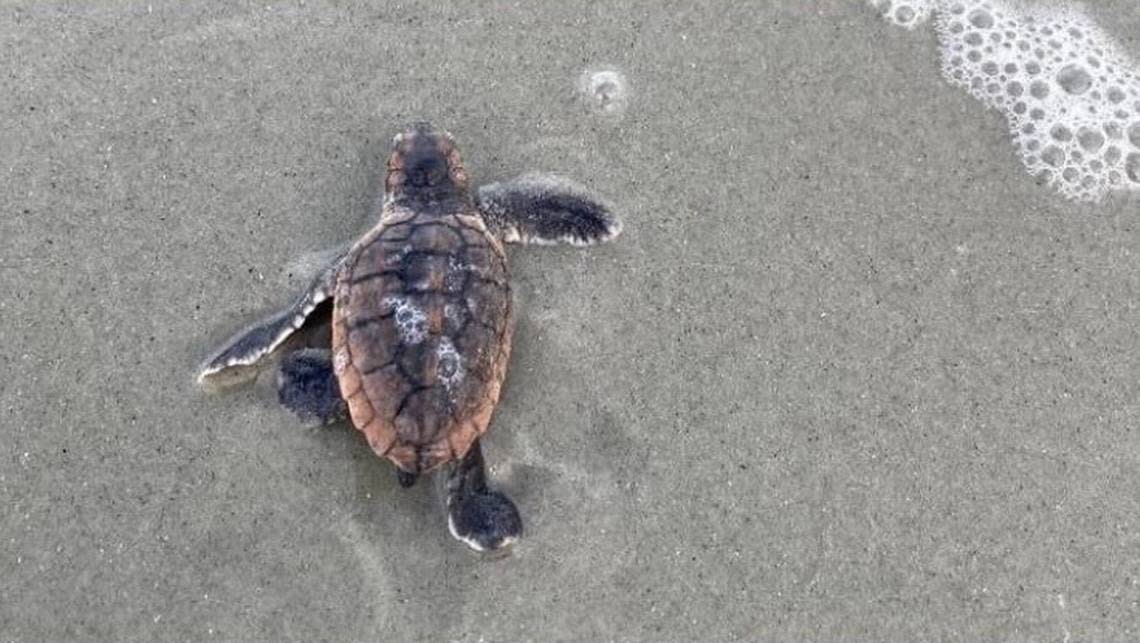Idalia destroyed hundreds of sea turtle nests. Which SC beaches were hit hardest?

When Idalia swiped South Carolina as a tropical storm last week, it left the habitats of thousands of the state’s tiniest visitors completely destroyed.
Idalia’s strong winds, heavy rains and storm surge that coincided with exceptionally high tides, known as King tides, resulted in the estimated loss of about 600 sea turtle nests up and down South Carolina’s coast, according to the state Department of Natural Resources’ Marine Turtle Conservation Program.
The storm’s timing couldn’t have been worse.
Sea turtle hatching season begins in July and wraps up in October, meaning that when Idalia hit, it was close to peak hatching season for the palm-sized babies.
Often denoted by an orange “loggerhead turtle nesting area” sign and cordoned off with plastic ribbon, each nest can contain about 120 eggs after the momma loggerhead lays. Those nests typically are situated in dunes, which are sought for safety.
The loggerhead sea turtle has stayed on the United States List of Endangered and Threatened Species since July 28, 1978.
The tiny turtles have it hard on South Carolina beaches, fending off the human footprint, crashing high tides and hungry predators. And for the hatchlings that make it to the ocean, they have a three-day, 70-mile swim in front of them to reach the Gulf stream. From there, about one in 100 will live to be 3 days old and only one in 1,000 will make it to adulthood.
But when tropical storms and hurricanes batter the coast, it can be instantly devastating for the hatchlings wriggling to the sea or the eggs incubating inside nests.
While the state DNR’s Nest Protection Network is still assessing the impacts to sea turtles from Idalia, the conservation program’s coordinator, Michelle Pate, said early reports show the hardest hit beaches were between Edisto Island and the Tom Yawkey Wildlife Center in Georgetown County.
“We did not see any real loss from our northernmost or southernmost beaches, North Myrtle Beach/Waites Island and Hilton Head Island, respectively,” Pate wrote in a Thursday email. “For nests that remained after the storm, we will wait until full incubation period to see how the presence of water affected final outcome/success of the nest.”
When Idalia sent water and winds crashing onto Hunting Island State Park on Aug. 30, seven sea turtle nests were lost and 18 were washed over, said Park Manager Zabo McCants. Luckily, four of the flooded nests had already hatched. By Friday, volunteers were allowed back to help with sea turtle nesting efforts.
On Hilton Head Island, 229 of the 348 nests had already hatched, and the Sea Turtle Patrol had already inventoried them before Idalia threatened the coast. Two nests were lost and 12 were significantly over-washed by the tides but were potentially viable, a Sea Turtle Patrol Hilton Head Island Facebook post noted.
But Edisto Beach State Park sea turtle nests fared far worse.
“We lost a significant amount of our nests,” said Samantha Pettit, an interpretative ranger at Edisto Beach State Park.
With King tides, it’s typical to lose a nest “here or there,” Pettit said, but Idalia was a different story. Before Idalia blew through, the park had “a little over 90 nests.” Now, about 20 remain. A combination of rain, wind and storm timing combined to make Idalia particularly destructive to the beach.
It’s been six years, back when Hurricane Irma tore through, since the park suffered such a widespread loss of sea turtle nests, Pettit said.
Normally, the park allows for the public inventory of sea turtle nests. Beginning in July, the public helps in the process of delicately digging up the nests, post-emergence, and calculating hatch success rates. But with Idalia’s ravaging, the park is no longer allowing the public to help for the remainder of the season.
The painful truth is that no one knows what they’re going to find in the nests that weathered the storm.
“We’ll still check them and if we see signs of hatching, we’ll inventory them,” Pettit said. “But we don’t know the status and we don’t want to do that for the public, considering we don’t even know if they’ll be viable.”
The SCDNR Nest Protection Network will continue to survey the state’s beaches, Pate said, particularly in areas where the densest nesting occurs, such as the Cape Romain National Wildlife Refuge.
The exact number of nests lost will be finalized at the end of the year.

